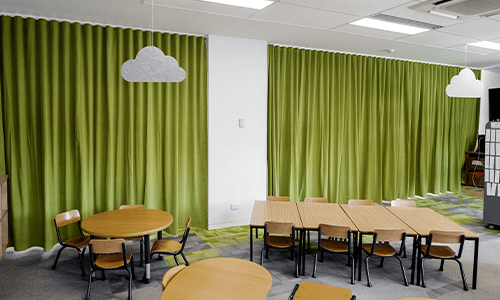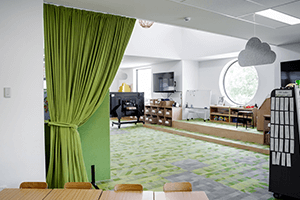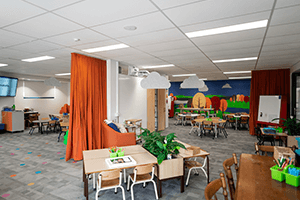Case study: How to manage distraction in the classroom
Installing acoustic curtains in classrooms can not only help keep noise levels low, but create flexible learning spaces and alleviate visual distractions.
Also see our other blog: New-style classrooms demand new thinking.

Among the most important skills a child must learn at school is the ability to focus on the task set for them. Managing distraction is an essential part of the learning process and forms the basis for successful comprehension during class.
But it’s not always easy in open-plan learning spaces where excessive noise and other distractions can have a negative impact on students’ concentration levels.
Schools up and down the country understand the benefits associated with open-plan learning spaces, which allow teachers to more easily run group-based activities requiring students across multiple classrooms to collaborate with one another.
The flipside is that these large spaces can generate distracting sights and sounds when students are required to take part in critical listening activities in small groups or when working on their own.
The solution, as many schools have found, is to install acoustic curtains that not only reduce classroom noise and cut down line-of-sight distractions, but allow for segmented and adaptable classroom spaces.
Schools that have installed acoustic curtains have found the flexibility they offer to be a key benefit. They can simply be opened when students are brought together for group activities and drawn when students are encouraged to concentrate.
Flexible learning spaces in action
Paul Wellham of St Philip’s Christian College, Newcastle, says children’s ability to focus by successfully managing their distractions is important for them to be able to succeed as learners.
As Head of Junior School at the independent non-denominational Christian college, Wellham has overseen the installation of acoustic curtains in a large, open-plan learning space in the Junior School’s new building. The curtains have brought flexibility to the teaching program and helped reduce the impact that distracting sights and sounds can have on students’ ability to concentrate.
“We have three classes per year level in the Junior School and flexible learning environments so the children aren’t in separate classrooms,” Wellham explains. “The building was completed in 2018 and what we discovered over the ensuing 18 months or so was that we needed to have greater flexibility over the open-plan space by zoning off areas of the open classroom. That’s where the acoustic curtains have helped.”
The acoustic curtains remain closed at the start of the day so students can take part in 1.5–2 hours of literacy learning time. The curtains are then opened for project-based learning across the year level, during which time students work on multi-disciplinary projects and the teachers assist as a team. They can be kept open for any other project-based learning activities involving the entire year level.
“The curtains offer great adaptability – it’s the definition of what classroom flexibility is about,” Wellham says.



Multiple applications, multiple benefits
St Philip’s installed sound-absorbing wall murals and other elements when the new building was fitted out. The installation of acoustic curtains has further improved the sound properties of the space used by students. But the curtains have had an additional benefit – they break up students’ line of sight so they aren’t distracted by a neighbouring class when doing class-based activities.
Feedback from the teachers using the space has been overwhelmingly positive, Wellham says. They report that being able to reduce visual distraction is one of the key advantages of the new curtains. They add that the curtains are easy to move and have been installed in a range of colours that complement the décor of each room.
“Our teachers have adapted well to some of the challenges of the space previously, but now they really appreciate the flexibility – and the learning benefits – offered by the acoustic curtains.”
Acoustic Blinds and Curtains is a provider of quality sound-absorbent products that can reduce noise levels and improve acoustics in classrooms and other open-plan spaces.

Hi We are a child care centre lookiing for some sound absorbing murals or drapes that can be draped on the ceilings.
Can you advise if we can purchase and install or would you do install?
Hi
Just wondering if you can use these types of curtains at home for a temporary room to be blocked off as overseas visitors are coming
Yes you can Boris – we’ll be in touch directly to discuss your noise problem and how we can help!